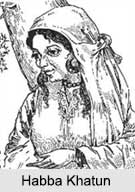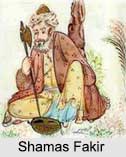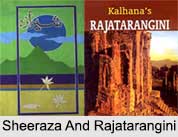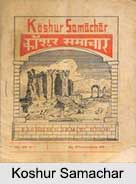 Kashmiri literature consists of a variety of folk forms and is the most representative form. It signifies many features of social change, actions, patterns, hopes, suppressed wishes, creative thoughts, unconscious yearnings and collective dreams.
Kashmiri literature consists of a variety of folk forms and is the most representative form. It signifies many features of social change, actions, patterns, hopes, suppressed wishes, creative thoughts, unconscious yearnings and collective dreams.
Kashmiri literature examines the social drama in the geographical frame and with mention to the historical compulsions. For its beauty, assortment and difficulty of explanation, Kashmiri literature has received the attention of various scholars of different fields of learning.
History of Kashmiri Literature
Kashmiri Literature began with the work "Mahanayakaprakash" (Light of the supreme lord) by Shitikantha in 1250 century. It was followed by the poet Lalleshvari or Lal Ded in 14th century. Habba Khatun came later in 16th century with her individual manner and was an exceedingly remarkable poetess, whose lyrics on love and romance referred to as "lol", beguiles by the Kashmiri people even to this date. Rupa Bhavani, Arnimal, Mahmud Gami, Rasul Mir, Maqbool Shah Kralawari and the Sufi poets like Shamas Fakir, Wahab Khar, Soch Kral, Samad Mir, and Ahad Zargar enriched the history of Kashmiri Literature.
 A number of well educated youth turned to Kashmiri Literature in 1950s and some of them were Dinanath Nadim, Rahman Rahi, Ghulam Nabi Firaq Amin Kamil, Ali Mohd Lone, Autar Krishen Rahbar etc. During medieval times, the great Kashmir Valley School of Art, Culture and Philosophy recognised as `Kashmir Shaivism` arose. Its memorable and irreplaceable masters comprise "Vasugupta" (c. 800), "Utpala" (c. 925), "Abhinavagupta" and "Kshemaraja". Names of the Anandavardhana and Abhinavagupta can successfully be enlisted in the theory of aesthetics. Several generations later, in the present-day contemporary times, a fresh lease of life given to identical "school of thought" was lent by Swami Lakshman Joo of Ishbher/Gupta Ganga, Srinagar.
A number of well educated youth turned to Kashmiri Literature in 1950s and some of them were Dinanath Nadim, Rahman Rahi, Ghulam Nabi Firaq Amin Kamil, Ali Mohd Lone, Autar Krishen Rahbar etc. During medieval times, the great Kashmir Valley School of Art, Culture and Philosophy recognised as `Kashmir Shaivism` arose. Its memorable and irreplaceable masters comprise "Vasugupta" (c. 800), "Utpala" (c. 925), "Abhinavagupta" and "Kshemaraja". Names of the Anandavardhana and Abhinavagupta can successfully be enlisted in the theory of aesthetics. Several generations later, in the present-day contemporary times, a fresh lease of life given to identical "school of thought" was lent by Swami Lakshman Joo of Ishbher/Gupta Ganga, Srinagar.
The earliest utilisation of Kashmiri literature can be witnessed in Kalhana`s "Rajatarangini" (12th century A.D.), in which a three-word phrase of Kashmiri "Apabhramsa" was beautifully made use of. However, the earliest masterpiece in Kashmiri literature appears to be the "Mahanayaprakasa" by Sitikantha Acharya, which belong to the period within, 1200-1500 A.D. Another work of supreme anonymity, without even a recognised date, is referred to as the Chumma-sampradaya, also furnishing as the oldest specimen of Kashmiri literature. The 14th century "Shaiva" woman-saint Lal Ded, also admired as Lalla Didi, indeed had composed umpteen authorships in Kashmiri, which are still very much well liked, both amongst Hindus and Muslims. The sayings of another mystical and spiritualist poet Sheikh Nuruddin (1377-1440 A.D.) have been amassed in the book named "Nurnama" or "Rshinama". Utthasoma, Yodhabhatta and Bhatta Avatara were the substantial Kashmiri poets in the court of Zainul Abidin (1420-1470 A.D.). Utthasoma`s treatise on music called "Manaka", Yodhabhatta`s "Jainacharita" and "Jainaprakasa" and Avatara`s "Jainavilasa"were authoritative works of this period. "Banasuravadha" is considered as the earliest epic poem in Kashmiri language. 
During the period subsequent to 1800 A.D., Kashmiri literature came under the heavy influence of Urdu and English, apart from Sanskrit and Persian, giving rise to novel ideas and styles. Mahmud Gami, Maqbul Shah, Paramanand and Wahhab Pare were some of the early poets from this period. Mahmud Gami had lent life to striking works like "Yusuf-Zulaikha", "Laila-Majnu" and "Shirin-Khusro". Gami had also composed an astounding number of ghazals. Paramanand had penned numerous narrative poems like "Radhaswaymvara", "Sudamacharita" and "Sivalagan" based upon Sanskrit Puranas. Abdul Wahab Pare (1845-1913) had adapted Firdausi`s Shahnama into Kashmiri and also in fact had interpreted the Akbarnama. Another skilled and proficient persona of the same period was Lakshman Ju, who had authored "Nala-Damayanti" and a number of ghazals and short verses in Kashmiri. The "Sikandarnama" by the 12th century poet Nizami was translated into Kashmiri by Maulavi Siddiqullah. K.F. Burkhard and G.A. Grierson were the two European scholars who had encouraged and boosted Kashmiri literature during the colonial period.
Significant Personalities of Kashmiri Literature
Significant and commanding poets in Kashmiri literature from the post-Independence period include Abdul Ahmad Azad, Dinanath Nadim, Amin Kamil, Ghulam Rasul Nazki, Rahman Rahi, Abdul Haqq Barq and Nur Mohammed Roshan. Dinanath Nadim`s verse instances like "Yirada", "Ba Gyavna Az" and "Zindabad Shyamji" had ushered in fresh dynamism into Kashmiri verse. He also had penned an opera referred to as "Bambur Yambarzal" in 1953, for which Dinanath Nadim had triumphantly fetched the Sahitya Akademi Award for Kashmiri literature in 1967. Nadim later came together with Roshan and rendered life to another opera, Himal ta Nagaraya in 1956. Rahman Rahi was also a recipient of the prestigious Sahitya Akademi Award (1962) for his Nauroz-i-Saba. Another Kashmiri writer, Akthar Mahiuddin also had earned the Sahitya Akademi Award in 1958 for his compilation of short stories named as "Sathsangar". Akthar Mahiuddin also owns to his recognition and acknowledgement two novels, "Dod Dag" and "Zuv ta Zolana", and another compendium of poems named Swanzal. Motilal Kemmu is a renowned dramatist who wrote powerful plays like Trunov, Mangay and Manjuli Nika.
Another Kashmiri writer, Akthar Mahiuddin also had earned the Sahitya Akademi Award in 1958 for his compilation of short stories named as "Sathsangar". Akthar Mahiuddin also owns to his recognition and acknowledgement two novels, "Dod Dag" and "Zuv ta Zolana", and another compendium of poems named Swanzal. Motilal Kemmu is a renowned dramatist who wrote powerful plays like Trunov, Mangay and Manjuli Nika.
During the contemporary era of 1950s, a number of well-informed and erudite youth turned to Kashmiri writing in the form of both poetry and prose, in the long run enriching modern Kashmiri writing by leaps and bounds. Amongst these bunch of writers are included Dinanath Nadim (1916-1988), Rahman Rahi, Muzaffar Aazim, Ghulam Nabi Firaq, Amin Kamil (1923-), Ali Mohd Lone, Akhtar Mohiuddin and Sarvanand Kaul `Premi`. Somewhat later day writers of the said genre comprise Hari Krishan Kaul, Majrooh Rashid, Rattanlal Shant, Hirdhey Kaul Bharti, Nazir Jahangir, Moti Lal Kemmu (playwright). Contemporary Kashmiri literature successfully come to sight in Sheeraza, issued and printed by the Jammu and Kashmir Academy of Art, Culture and Languages, Anhar, published by the Kashmiri Department of Kashmir University, and an independent magazine named Neab International Kashmiri Magazine.
Contemporary Kashmiri literature appears in "Sheeraza" published by the Jammu and Kashmir Academy of Art, Culture and Languages, "Anhar" published by the Kashmirri Department of the Kashmir University, and an independent magazine "Neab" International Kashmiri Magazine published from Boston, "Vaakh" (published by All India Kashmiri Samaj, Delhi) and "Koshur Samachar" ( published by Kashmiri Sahayak Sammiti, Delhi).













